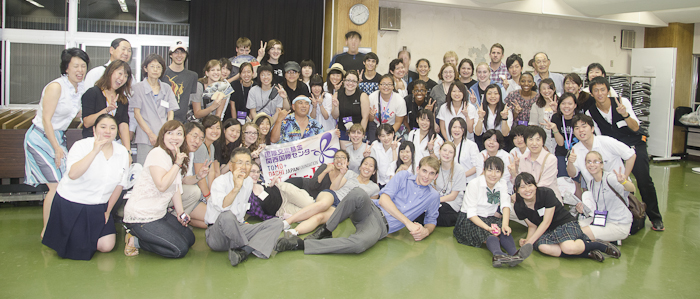


by Thomas Lin, Program Officer, JFLA
Previous Issue: US-Japan High School Students Summit in Rikuzentakata 2012
In the morning we hopped on the bus and headed towards Sendai. This was the longest ride thus far at about three and a half hours. When we got to the city, the bus made its way to Sendai Castle where we had lunch. Afterwards, we had some time and were able to walk around the castle; however, many participants didn’t know that this was the castle. There were lots to see there including Gokoku Shrine, a large equestrian statue of Date Masamune, and various shops and vendors.
That afternoon, representatives from Sendai University gave the participants a tour of the city. There was a popular shopping district nearby that many groups went to as well as the Pokemon center, which was a short bus ride away. Some even went back to Sendai castle to complete an assignment not knowing that they were there earlier. This was the most free-time the participants had in a populous area in Japan since the trip started about a week earlier. The change in activities allowed the participants to have some fun time so everyone could unwind after the activities in Iwate prefecture. After everyone returned that night, the group had dinner and then called it a day.
The following morning, we were greeted by Cameron Peek who is a current JET participant and our guide during our tour of Ishinomaki. He was also a friend of Taylor Anderson and was living in Sendai during the disaster. We were also greeted by the wife of Ichiro Fujisaki, Ambassador of Japan to the United States, and her daughter who also accompanied us to Ishinomaki.
The first stop was to the temporary location of Watonoha elementary school where we toured the school and also Taylor Bunko (Taylor’s Reading Corner). Shinichi Endo, the woodworker who made the bookshelfs to commemorate the work of Taylor Anderson was also on hand to share a few words and also handed out fans to the participants. Endo lost three children of his own to the tsunami and two of them were students of Taylor Anderson. Afterwards, we departed for the original Watanoha elementary, which is mostly still intact, but has suffered severe water damage from the tsunami. We were able go inside to witness the damage first hand. Time stood still inside the school as everything was left as it was right up until the day of the disaster. The destructive forces of nature was evident everywhere, even a heavy safe holding important documents of the school did not escape the carnage. Water stains were visible on the walls marking the height of the water that made its way into the building. Outside, there were drawings on the walls showing signs of hope for the future of the school. The next stop was to the location where they found the body of Taylor Anderson and everyone paid their respects in a moment of silence and prayer.
We then headed to the temporary building that was used by relief workers as a command post where we had lunch and watched a presentation about the Tsunami. From what I gathered, Ishinomaki was one of the most populated areas in the Tohoku region and as a result suffered the most casualties and destruction from the tsunami. After the presentation, we divided up into four different groups and toured the city. We were bussed to Hiyoriyama Park where we could get a 360 degree view of the area and survey the damage that was caused. Afterwards, we descended from the park in narrow city streets to the city center for some free time to walk around. There was some temporary shops setup so the locals had a place to shop and the participants found interest in the anime character statues placed on the sidewalk.
Later in the afternoon, we met up with the Kiwi Club for an exchange session. This was a group of students and friends of Taylor Anderson from the Ishinomaki area. They enjoyed learning English and were interested in meeting and talking with the JET-MIP participants. There were also three participants in the JET Program who also joined the exchange. The meeting lasted for about an hour while everyone had a good time over refreshments and snacks. At the end of the night some of the partcipants gave speeches as well as members of the Kiwi Club and then we got back on the bus for the long ride back to Sendai. This would cap off our visit to the Tohoku region as we would return to Osaka the following day.
Next Issue: Return to Osaka